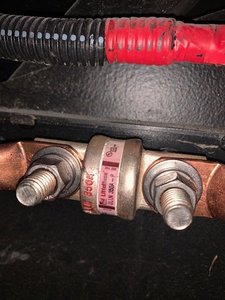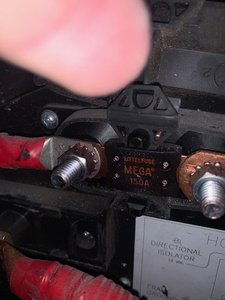TJ&LadyDi
RVF "Dinosaur"
It's actually not that big; about 5" x 10" x 0.5" thick.Physically..how big is that thing? Looks like it could be the size of a jeep hood, but perspective is absent.
2019 DSDP 4369 * Active Air * NHSO
TJ
Follow along with the video below to see how to install our site as a web app on your home screen.
Note: This feature may not be available in some browsers.
It's actually not that big; about 5" x 10" x 0.5" thick.Physically..how big is that thing? Looks like it could be the size of a jeep hood, but perspective is absent.
2019 DSDP 4369 * Active Air * NHSO
300amp, not 30amp. It looks like a giant all’s-seltzer. There’s a pic of it earlier in the threadWow John. Thanks for the synopsis. I will put these fuses on my shopping list. I have about every other size, but not 30 amp. I have learned a lot here. I must admit, I would have eliminated the fuse after the continuity test as well. Thanks again.
@MapNerd ... thanks for the detailed recap and you make some excellent points here. It's always good to hear how things wind up. Following this thread has really helped me should I ever get in this situation. As a result I decided to go look at my fuse just to make sure I have the proper replacement … and find that I actually have two (2) of them. A 350 amp and a 150 amp.Well let me recap everything with all the information as I have it, in it’s corrected form and maybe that will put some of the questions at ease.
So a couple of lessons here.
1. Read the manual and do what it says in its entirety. Not just the last sentence. Had I done that, I would have solved it the night before (though I didn’t have another 300amp fuse on hand to correct it).
2. Pay attention to your systems. That wasn’t my problem here but it could have easily been. It was entirely possible initially that I’d lost power at the pedestal earlier in the week and didn’t know and my batteries had been discharging the entire time.
3. Learn how to use your multimeter. It’s an invaluable tool. I used it for almost every single test I performed but unfortunately, it was my first time ever using one so I didn’t know exactly what I was doing. Only had a vague idea.
4. Always post on RVForums.com and try to be as accurate as possible. I gave inaccurate descriptions and test results and several folks on here still knew what it was. The amount of knowledge here is amazing.
5. Carry extra 300amp fuses.
6. Always ask what happened two seconds before this incident.
Thanks to everyone who participated in helping me solve it. I hope this post helps someone else down the road.


